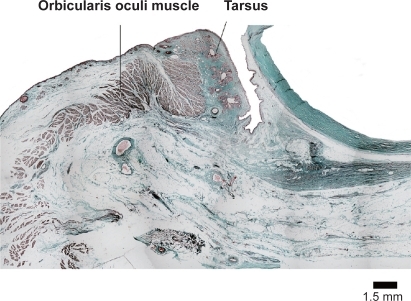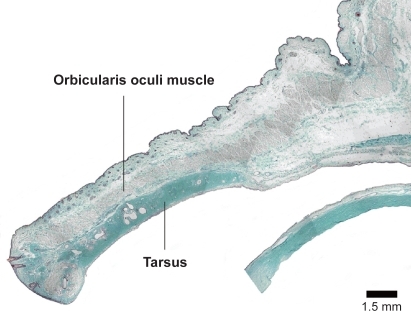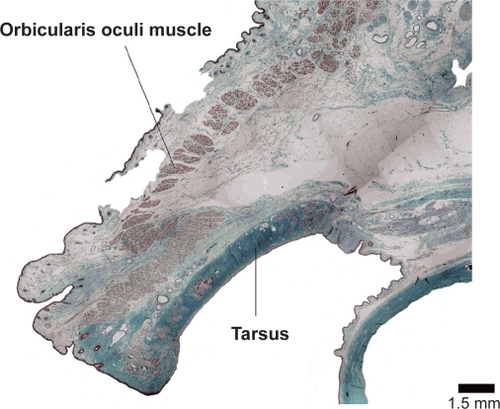Abstract
We aimed to microscopically examine whether Caucasian eyelids demonstrate overriding of preseptal orbicularis oculi muscle (OOM) over the pretarsal OOM in both lower and upper eyelids. Full thickness sections of 13 lower eyelids and 11 upper eyelids from seven Caucasian cadavers were examined. In the lower eyelids, all 13 specimens demonstrated clear overriding of preseptal OOM over the pretarsal OOM. The overriding part extended almost to the level of lower eyelid margin. However, in the upper eyelids, only one of the 11 eyelids demonstrated overriding, and the overriding part only extended to the level of mid-tarsal plate. Our result strongly supports the hypothesis of overriding of the preseptal OOM over the pretarsal OOM as an etiology of involutional lower eyelid entropion. The relatively low frequency of upper eyelid overriding preseptal OOM in our study reflects and may explain the rare occurrence of involutional upper eyelid entropion.
The etiology of involutional lower eyelid entropion has been hypothesized to be a combination of horizontal and longitudinal lower eyelid laxity,Citation1–Citation4 and overriding of the preseptal orbicularis oculi muscle (OOM) over the pretarsal part of the OOM.Citation5 Examination of lower eyelid laxity is relatively easy and can be achieved by several known methods,Citation6,Citation7 in contrast, examination of overriding preseptal OOM is difficult.Citation8 Entropion surgery such as Wheeler’s procedure,Citation9 where horizontal tightening of the OOM results in resolution of entropion provides indirect evidence to the hypothesis that overriding of OOM as an etiology of involutional entropion. However evidence in support of this hypothesis remains scarce and therefore the role of overriding OOM in the etiology of involutional lower eyelid entropion is still controversial.Citation10–Citation12
Overriding of preseptal OOM over the pretarsal OOM has been shown in microscopic cadaveric study of Asian lower eyelids to be a typical feature in Asian eyelids.Citation13 This feature is thought to influence the fuller appearance of Asian lower eyelid, and possibly a causative factor of involutional lower eyelid entropion.Citation13 None of the eyelids in this study demonstrated entropion even though cadaveric eyelid tends to loosen horizontally secondary to loss of basal muscular tone.Citation14 For Caucasian lower eyelids, there has been no microscopic cadaveric studies,Citation15 magnetic resonance imaging (MRI), or any other imaging studiesCitation16,Citation17 done for overriding of preseptal OOM. In addition, previous imaging or microscopic cadaveric studies in the upper eyelid were not focused on the overriding of the preseptal OOM on the pretarsal part, and overriding has not been identified as a causative factor of involutional upper eyelid entropion.Citation18
The purpose of this study was to microscopically examine Caucasian cadavers to determine whether both lower and upper Caucasian eyelids demonstrate any overriding of preseptal OOM over the pretarsal OOM.
Materials and methods
The process of procuring the eyelid samples has been previously described.Citation13,Citation19 During dissection, none of the cadavers demonstrated entropion in both the lower and upper eyelids. Full thickness sections of 13 lower eyelids (7 right and 6 left) and 11 upper eyelids (7 right and 4 left) from seven Caucasian cadavers (age range: 78–101 years old at death; age average: 87.7 years old) were fixed in 10% buffered formalin. Sagittaly sliced sections of the central part were stained with Masson’s Trichrome and examined under the microscope. Micrographs were taken with a digital camera system attached to the microscope.
All the cadavers were registered with the University of Adelaide, and proper consents and approvals were obtained prior to use. Methods for securing human tissues were humane and complied with the tenets of the Declaration of Helsinki.
Results
In the lower eyelids, all 13 specimens demonstrated clear overriding of the preseptal OOM over the pretarsal OOM (Figure ). The overriding part extended almost to the level of lower eyelid margin. However, in the upper eyelids, 10 eyelids did not show any overriding (Figure ), and only one of the 11 eyelids demonstrated overriding (Figure ) in which the overriding part only extended to the level of mid-tarsal plate.
Figure 1 The preseptal orbicularis oculi muscle of the lower eyelid overrides over the pretarsal orbicularis oculi muscle. Bar = 1.5 mm.

Discussions
Overriding of the preseptal OOM over the pretarsal OOM in the lower eyelid was present in all the Caucasian cadavers, but all but one did not show any overriding in the upper eyelid. The finding in the lower eyelids is similar to that from previous studies on Asian lower eyelids.Citation13 We believe this overriding to be a common feature between races in cadaveric lower eyelids.
As cadavers are usually kept without head support and take up a chin-up position, lower eyelid preseptal OOM may be easily moved toward the eyelid margin and override the pretarsal OOM due to effects of gravity. On the contrary, gravity pushes the pretarsal OOM of the upper eyelid cranially, and may explain why all upper eyelids but one did not show the overriding of the preseptal OOM to the pretarsal part of the OOM.
The condition of the lower eyelid in the dead is similar to that of involutional lower eyelid entropion. In both states, the lower eyelids are loosened horizontally. The lower eyelid in the dead allows for the movement of OOM towards the eyelid margin. As vertical laxity did not seem to present in the cadavers and the movement of OOM is thought to have occurred slowly and less dynamically, they may have prevented the manifestation of lower eyelid entropion. Despite this, the presence of overriding preseptal OOM over the pretarsal OOM was clearly elucidated. Thus, this finding strongly supports the hypothesis that overriding of the preseptal OOM could be an etiology of involutional lower eyelid entropion. In addition, as all but one of the upper eyelids did not show any overriding, this finding reflects and may explain the rare occurrence of involutional upper eyelid entropion.Citation18
The overriding part of the lower eyelid extended almost to the level of lower eyelid margin, but the overriding part in the upper eyelid extended to the level of mid-tarsal plate. Considering the effects of gravity, the lower eyelid is pushed anteriorly by the orbit, but the upper eyelid is pushed posteroinferiorly. This concept originates from understanding the pathophysiology of “post-enucleation socket syndrome”.Citation20 In this situation, the lower edge of the lower tarsal plate is pushed anterosuperiorly, but the upper edge of the upper tarsal plate is pushed posteroinferiorly. Therefore, in the lower eyelid, overriding of the preseptal part over the pretarsal part can effectively invert the lower eyelid margin, but in the upper eyelid, as the overriding part and the rotation axis is far from the upper eyelid margin, involutional upper eyelid entropion seldom occurs.Citation18
Overriding of the preseptal over the pretarsal OOM has not been the focus in previous MRI studies of the eyelid.Citation16,Citation17 Therefore even though some MRI scans of Asian eyelids in the literatureCitation16 showed overriding preseptal OOM, the finding was not reported. However, even in the presence of involutional lower eyelid entropion, preseptal overriding is difficult to observe in vivo. We believe this is because the force needed to produce overriding preseptal OOM may have be used instead to invert the lower eyelid margin and thus it manifests as entropion instead of observable overriding preseptal OOM.
Although overriding preseptal OOM is demonstrated in both Caucasians and Asians,Citation13 there remain several differences in lower eyelid anatomy between both groups. One major difference is the orbital fat in Asians extends anterosuperiorly to the inferior border of tarsal plate,Citation16 but in Caucasians the orbital fat extends superiorly only to the point of confluence of the capsuloplapebral fascia with the orbital septum,Citation21 approximately 5 mm below the inferior tarsal border.Citation18 This difference may be why Caucasians suffer from much less involutional lower eyelid entropion than Asians.Citation21
The shape of OOM is a little different between generations.Citation22 In the young specimen of the lower eyelid, the muscle bundles of the pretarsal OOM are located in a line along the tarsus and made a U-turn toward the skin, giving the muscle an S shape. The muscular shape of the pretarsal OOM, resembling a chrysanthemum petal, is compact to provide movement to the tarsus. The bundle shape of the pretarsal OOM is quite different compared with that of the preseptal OOM. In the aged specimen of the lower eyelid, the pretarsal muscles are joined together and S shape was less clear. In addition, the preseptal OOM is pressed forward and its thickness is reduced by herniation of the orbital fat. The involutional lower eyelid entropion may be caused by these involutional changes.
The drawbacks of this study are only sampling the old-age cadavers and in vivo samples could not be used. However, it was very difficult to take young cadavers, and we were obliged to take cadaveric study as the current findings were difficult to observe in vivo.
In conclusion, all 13 lower eyelids specimens and only one of the 11 upper eyelids demonstrated clear overriding of preseptal over the pretarsal OOM. The overriding part extended almost to the level of lower eyelid margin but only to the level of mid-tarsal plate in the upper eyelid. These results strongly support the hypothesis that overriding of the preseptal over the pretarsal OOM is one of the etiologies of involutional lower eyelid entropion. This may explain the rare occurrence of the involutional upper eyelid entropion.
Disclosure
The authors report no financial support and no financial interest related to this manuscript.
References
- JonesLTReehMJTsujimuraJKSenile entropionAm J Ophthalmol196355463469
- CollinJRORathbunJEInvolutional entropion. A review with evaluation of procedureArch Ophthalmol19789610581064418757
- BengerRSMuschDCA comparative study of eyelid parameters in involutional entropionOphthal Plast Reconstr Surg19895281287
- HaefligerIOPiffarettiJMLid retractors desinsertion in acquired ptosis and lower lid entropionKlin Monatsbl Augenheilkd200121830931211417323
- DanksJJRoseGEInvolutional lower lid entropion. To shorten or not to shorten?Ophthalmology1998105206520679818607
- FanteRGElnerVMTranscaruncular approach to medial canthal tendon plication for lower eyelid laxityOphthal Plast Reconstr Surg2001171627
- OlverJMSathiaPJWrightMLower eyelid medial canthal tendon laxity grading: an interobserver study of normal subjectsOphthalmology20011082321232511733279
- KakizakiHZakoMMitoHMagnetic resonance imaging of pre- and postoperative lower eyelid states in involutional entropionJpn J Ophthalmol20044836436715295663
- WheelerJMSpastic entropion correction by orbicularis transplantationTrans Am Ophthalmol Soc19383615716216693144
- JonesLTThe anatomy of the lower eyelid and its relation to the cause and cure of entropionAm J Ophthalmol196049293614407746
- HurwitzJJSenile entropion: the importance of eyelid laxityCan J Ophthalmol1983182352376627116
- JacksonSTSurgery for involutional entropionOphthalmic Surg1983143223266346197
- KakizakiHJinsongZZakoMMicroscopic anatomy of Asian lower eyelidsOphthal Plast Reconstr Surg200622430433
- HenssgeCLunkenheimerPPSalomonOSupravital electrical excitability of musclesZ Rechtsmed1984931651746528746
- HawesMJDortzbachRKThe microscopic anatomy of the lower eyelid retractorsArch Ophthalmol1982100131313187103816
- CarterSRSeiffSRGrantPEThe Asian lower eyelid: a comparative anatomic study using high-resolution magnetic resonance imagingOphthal Plast Reconstr Surg199814227234
- GalatoireOTouitouVHeranFHigh-resolution magnetic resonance imaging of the upper eyelid: correlation with the position of the skin crease in the upper eyelidOrbit20072616517117891644
- MillerDGHesseRJInvolutional entropion of the upper lidOphthal Plast Reconstr Surg199061620
- KakizakiHZakoMNakanoTThe levator aponeurosis consists of two layers that include smooth muscleOphthal Plast Reconstr Surg200521379382
- SmitTJKoornneefLZonneveldFWComputed tomography in the assessment of the postenucleation socket syndromeOphthalmology199097134713512243686
- CarterSRChangJAguilarGLInvolutional entropion and ectropion of the Asian lower eyelidOphthal Plast Reconstr Surg2000164549
- IwanamiMTsurukiriKHistological comparison between young and aged specimens of the oriental lower eyelid using sagittal serial sectionsPlast Reconstr Surg20071192061207117519701

